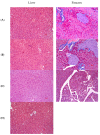Effect of the Composition of Leuzea and Cranberry Meal Extracts on Metabolic Processes in Norm and Pathology
- PMID: 37242551
- PMCID: PMC10221024
- DOI: 10.3390/ph16050768
Effect of the Composition of Leuzea and Cranberry Meal Extracts on Metabolic Processes in Norm and Pathology
Abstract
This study was conducted to evaluate the effects of long-term administration of a new herbal composition of leuzea and cranberry meal extracts at a dose of 70:500 mg/kg in healthy and pathological mice. After 4 weeks of daily composition administration to healthy CD-1 mice and C57BL/6 mice with diet-induced metabolic syndrome, oral glucose tolerance test (OGTT), serum biochemical examination and histology of internal organs were performed. Additionally, histological examination of white and brown adipose tissue was performed to evaluate the ability of the composition to prevent abdominal obesity in C57BL/6Ay (agouti yellow) mice. The results showed that the composition increased tissue sensitivity to glucose in healthy CD-1 mice; at the same time, it did not worsen the course of pathological processes in pathological mice. In both cases, the application of the developed composition was safe and contributed to the restoration of metabolic parameters.
Keywords: adipocytes; cranberry; ecdystene; extracts; leuzea; metabolic syndrome; mice; ursolic acid.
Conflict of interest statement
The authors declare no conflict of interest. The funders had no role in the design of the study; in the collection, analyses, or interpretation of data; in the writing of the manuscript; or in the decision to publish the results.
Figures






Similar articles
-
Chinese medicine Jinlida granules improve high-fat-diet induced metabolic disorders via activation of brown adipose tissue in mice.Biomed Pharmacother. 2019 Jun;114:108781. doi: 10.1016/j.biopha.2019.108781. Epub 2019 Mar 20. Biomed Pharmacother. 2019. PMID: 30903919
-
Adipocyte-specific Hypoxia-inducible gene 2 promotes fat deposition and diet-induced insulin resistance.Mol Metab. 2016 Sep 28;5(12):1149-1161. doi: 10.1016/j.molmet.2016.09.009. eCollection 2016 Dec. Mol Metab. 2016. PMID: 27900258 Free PMC article.
-
Cranberry Attenuates Progression of Non-alcoholic Fatty Liver Disease Induced by High-Fat Diet in Mice.Biol Pharm Bull. 2019;42(8):1295-1302. doi: 10.1248/bpb.b18-00984. Biol Pharm Bull. 2019. PMID: 31366865
-
Bone morphogenic protein 9 is a novel thermogenic hepatokine secreted in response to cold exposure.Metabolism. 2022 Apr;129:155139. doi: 10.1016/j.metabol.2022.155139. Epub 2022 Jan 19. Metabolism. 2022. PMID: 35063533
-
5-aminolevulinic acid combined with ferrous ion reduces adiposity and improves glucose tolerance in diet-induced obese mice via enhancing mitochondrial function.BMC Pharmacol Toxicol. 2017 Jan 30;18(1):7. doi: 10.1186/s40360-016-0108-3. BMC Pharmacol Toxicol. 2017. PMID: 28132645 Free PMC article.
Cited by
-
Cranberry supplementation improves physiological markers of performance in trained runners.Phys Act Nutr. 2023 Dec;27(4):8-14. doi: 10.20463/pan.2023.0032. Epub 2023 Dec 31. Phys Act Nutr. 2023. PMID: 38297471 Free PMC article.
References
Grants and funding
LinkOut - more resources
Full Text Sources

